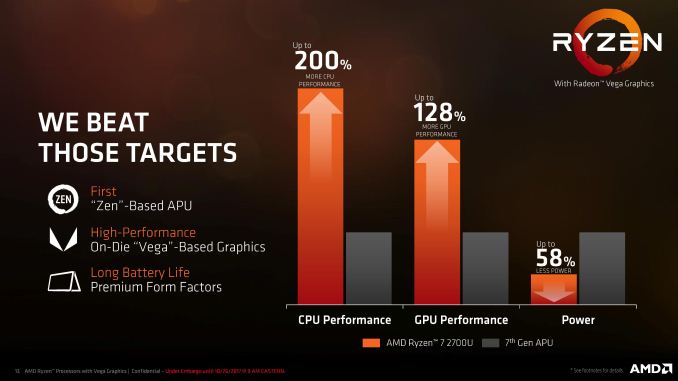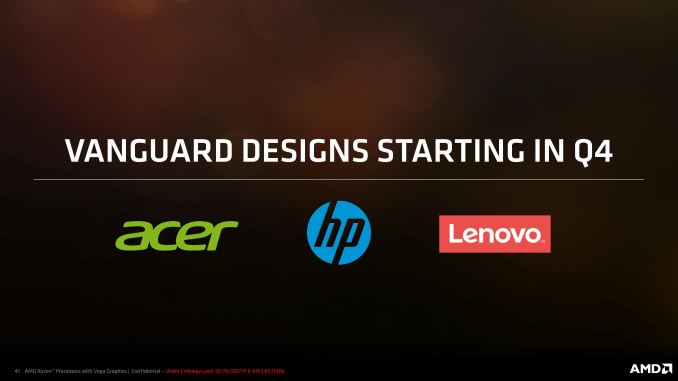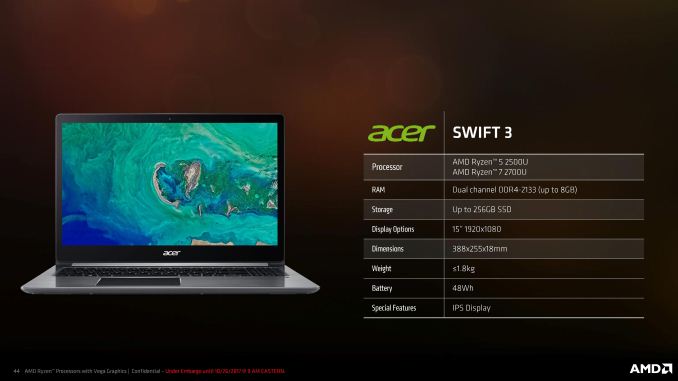Ryzen Mobile is Launched: AMD APUs for Laptops, with Vega and Updated Zen
by Ian Cutress on October 26, 2017 9:00 AM ESTAMD Ryzen Mobile: Zen 1.5
During our pre-briefings on Ryzen Mobile, it was asked why the two new APUs were using the 2000-series numbers, and not the 1000-series numbers like the desktop parts. It was assumed by the press that the first generation of Ryzen would all be under the 1000-series, including the mobile parts. The response given by Kevin Lensing, AMD’s Corporate VP of the Client Business Unit, was that so many of the design ideas that AMD wanted to put into the original desktop Ryzen (but couldn’t due to time) eventually ended up in Ryzen Mobile, such as the updated precision boost. While there are no architectural changes to Zen to warrant a next-generation microarchitecture name, this version of Ryzen’s periphery (i.e. the power) was more in-line with an original vision and had to be presented as such. This is why we have Ryzen 7 2700U, rather than a Ryzen 7 1700U. He would not comment if the true next generation Ryzen desktop naming would still be the 2000 series, or if we would go straight to 3000. Who knows, it might alternate.
The state of Zen aside, AMD’s return to high-performance computing with the Zen core was naturally going to trickle down into the notebook space. The question everyone asked is if such a high-power, high-performance core was going to make it in such a small power envelope: especially when you add some big graphics core next to it. In our desktop Ryzen reviews, we saw per-core power go as low as 8W per core, and AMD’s Vega was power hungry – promising to put four cores and some graphics into a single piece of silicon with a 15W TDP sounded harder than an uphill task, almost Sisyphean in nature. AMD has approached that by taking new methods to its power topology, how it manages that power, and found a combination of frequencies and performance that tally up to that 15W mark. They have also worked closely with the first three OEMs that are launching systems today to ensure a good user experience.
For performance, Ryzen Mobile has four cores with multithreading, with frequencies up to 3.8 GHz. This should give the mobile processor enough grunt under the hood in the 15W envelope to cater for a significant number of demanding workloads. GPU performance is also up, with AMD also hoping to push the hardware into a number of gaming-focused devices with FreeSync panels in the new few months. AMD is also touting significant power reductions during high-load tasks, leading to a 270% performance per watt improvement. More impressive is the steps taken towards how the processor manages power between cores and the GPU: a very complex implementation hopefully leading to a better power profile and 15-30% better battery life than previous generations for common use cases.
For the launch, AMD has partnered with HP, Acer and Lenovo for systems to go on shelves. As I am currently writing this, only HP provided any information about their upcoming systems and we’re likely to scramble when the other press releases come out. None of the three designs are ultimate eye-catching flagships, but rather approaching that middle-range $600-$1000 notebook territory with 13.3 inch 4K displays, up to 1TB SSDs, 48-55Wh batteries, and a device or two that can flip into a tablet. When we played briefly with the Acer unit in our pre-briefing, there was no lag – a user would be hard-pressed to immediately see a difference to a comparative Intel system.
Ultimately AMD has several very hard tasks ahead of it for Ryzen Mobile. Firstly it has to re-educate the sales teams at brick and mortar stores like Best Buy, who have only ever seen AMD has the low-cost budget option. If they still think the same way when Ryzen Mobile comes to town, they won’t be recommending them.
Second, they have to educate the public – after years of miserable user experiences leading to negative feedback loops, AMD has to convince these users that it is worth looking at AMD-powered devices again and there isn’t some sort of catch. Part of this solution will be in how well AMD integrates itself into the OEM sampling strategy for reviews, and if any reviewers are going to get devices this time around.
Third, AMD is several steps behind Intel in its marketing message: while Intel is trying to explain new ways to use the hardware (such as the failed ‘PC Does Whaaat?’ campaign almost a couple of years ago to the day), AMD is on the ‘I’m here too, and I’m just as good’ message. Back when we analyzed the Carrizo user experience, one thing we pointed out is that with most Intel flagships, most users do not even know what processor is inside – to these customers, saying ‘I’m just as good’ might give the impression ‘well what was wrong before?’. It might take AMD a round of flagships and XPS 13 or Zenbook Infinity-type designs to get the attention on their side of the discussion.
We have reached out to all three of the main OEMs who have Ryzen Mobile systems being announced today, but only one responded in time. This doesn’t bode well for any sampling, but we’re sitting here with a megaphone until we get one. Stay Tuned.
As part of this launch, AMD also discussed its progress towards its 25x20 goal, and AMD actually provided some data on how they are calculating this. We analyzed what AMD still has to do in a separate article, and you can read about it here:
http://www.anandtech.com/show/11965/amds-progress-on-its-25x20-goal-the-task-ahead














140 Comments
View All Comments
serendip - Friday, October 27, 2017 - link
Indeed. I've got 3 windows of Firefox running with a total of 50 tabs plus LibreOffice - all on an Atom tablet with 4 GB RAM. Typical office workflows don't need more than 4 GB especially as Windows 10 is quite memory-efficient. I've even run Ubuntu desktop VMs on this tablet with no hiccups.extide - Friday, October 27, 2017 - link
If you're using 7GB then you should have 16GB in there otherwise you will have no room for disk cache. You really don't want your actual apps to be using all of your physical memory..mdriftmeyer - Friday, October 27, 2017 - link
5 to 7 GB in Brower on top of several GBs for the OS. Do the math.Icehawk - Friday, October 27, 2017 - link
Would love to see a SS showing 5gb of explorer windows, good luck with that.extide - Friday, October 27, 2017 - link
ECC isn't really effective against rowhammer as it induces multi-bit errors. Really, rowhammer isnt much of an issue in the real world.Krysto - Thursday, October 26, 2017 - link
I'm hoping AMD adopts the new codec (AV1 or NETVC, whichever it is), ASAP, if it's finalized by the end of the year. I guess it will be too late to go into Zen 2 for next spring, but it should be supported in Zen 3 at least.MajGenRelativity - Thursday, October 26, 2017 - link
It takes time for CPUs to be developed, so it probably depends on how far the codec is along, and how closely AMD is involved.extide - Friday, October 27, 2017 - link
The codecs will track the GPU's so based on that timetable it is unlikely to get into Navi, so whatever comes after Navi and then whatever APU uses that post-Navi GPU.mdriftmeyer - Friday, November 3, 2017 - link
They'll never adopt a VP9 based codec in hardware. Why? Google has abandoned it and isn't developing it further. They're transferring it to Cisco.However, Google decided to incorporate VP10 into AOMedia Video 1 (AV1). The AV1 codec will use elements of VP10 as well as the experimental formats Daala (Xiph/Mozilla) and Thor (Cisco).[94][95][96] Accordingly, Google has stated that they will not deploy VP10 internally or officially release it, making VP9 the last of the VPx-based codecs to be released by Google.
NETVC will also never be added to hardware. Unless you think AMD or Nvidia will bank on anything outside of the MPEG LA you're dreaming.
peevee - Thursday, October 26, 2017 - link
Sounds very very sweet. Especially if laptops with all that power can be made with passive cooling (15W should be fine in a proper metal design).